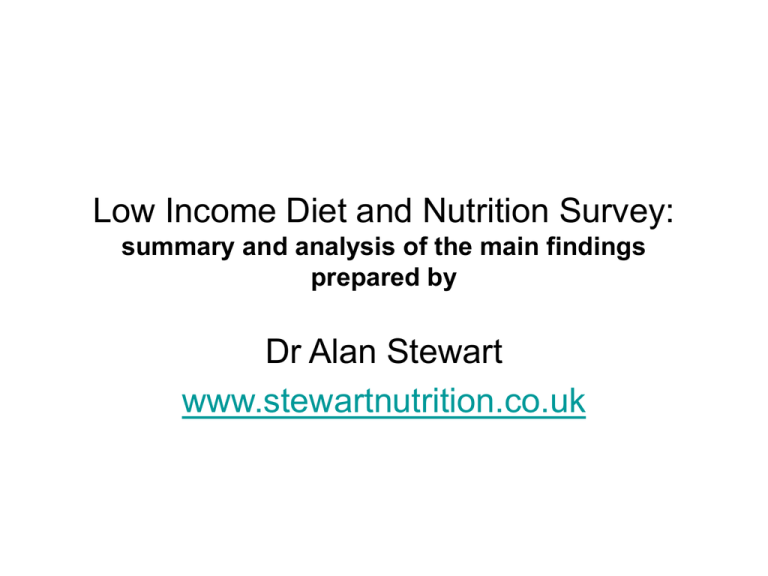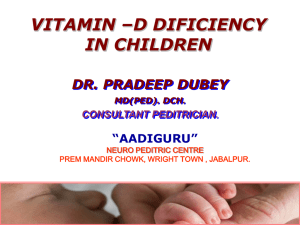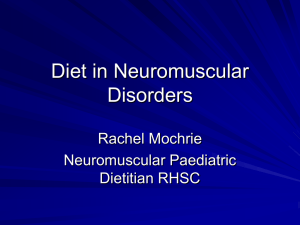
Low Income Diet and Nutrition Survey:
summary and analysis of the main findings
prepared by
Dr Alan Stewart
www.stewartnutrition.co.uk
Low Income Diet and Nutrition Survey:
Lecture Contents and Slides
• Introduction 3-5
• Methodology, Analysis, Population
Characteristics 6-12
• Malnutrition: undernutrition 13-20
• Malnutrition: overnutrition 21-24
• Malnutrition Risk Factors: socio-economic
and personal 25-55
• Lessons from History
Poverty and Malnutrition: Background
• Though the industrial and agricultural revolutions did much to
reduce widespread food shortages malnutrition still occurs
• Landmark discoveries in nutrition made in the 20th century began to
document the specific impact of poor nutrient intake on health
• These discoveries and the need for even food distribution during the
two World Wars resulted in the formulation of advice and food
policies to prevent undernutrition in the general population
• Financial hardship and deprivation are not the only determinants of
inadequate food intake and malnutrition in the UK population
• Poor nutrient status affects all age groups - growth, development,
physical and mental health, earning capability and longevity
• Correcting undernutrition benefits both the individual and society
• To correct problems of malnutrition requires an understanding of the
findings of nutritional surveys as well as lessons from history
Malnutrition and Health
• The term malnutrition covers both undernutrition and overnutrition
• In the UK obvious severe undernutrition is not common outside of
serious illness or dietary problems but overnutrition – obesity, is
• Numerous nutritional surveys of the UK population reveal that mild
deficiencies of micronutrients are not uncommon, may co-exist with
overnutrition and can adversely influence physical or mental health
• Deficiencies of three micronutrients (iron, vitamin A and iodine) in all
countries are monitored by the WHO and are only marginally more
common in the low income groups in the UK. www.int/vmnis/en
• However, deficiencies of folate, vitamins D and C are more common
and potentially affect health in all age groups
• The causes of the these and other deficiencies include poor food
choices, illness, smoking, alcohol excess and lack of sun exposure
Classifying Diet-Related Health Problems
Undernutrition
•
•
•
•
•
•
Poor Growth - Protein-energy, vitamin A and iodine
Underweight – Protein-energy
Anaemia – Iron, folate, vitamins B12 and C
Rickets and Osteoporosis - Calcium and vitamin D
Poor Pregnancy Outcome – Folate, severe anaemia, vitamins C and D
Major Deficiency Syndromes – Vitamin C (scurvy), vitamin B1(beri-beri) etc.
Overnutrition
•
•
•
•
Obesity – Energy from food or alcohol
Hypertension – Obesity, excess of sodium and alcohol
Poor Pregnancy Outcome – Obesity, excess of vitamin A
Liver disease – Obesity, alcohol, excess of iron or vitamin A
Unwise Food Choices
•
•
Increased Mortality – vascular disease and cancer mainly
Increased Morbidity – many: dental caries, digestive problems, food allergy
Low Income Diet and Nutrition Survey of the
UK Population (2008): Methodology
• Being in receipt of benefits has often been associated with a
less healthy diet and poorer nutritional state and health
• The LIDNS was commissioned by the Food Standards Agency
to assess the nutritional status of this group
• A representative sample aged 2 to over 80 years was drawn
from those in the most deprived 15% of society, living in a
household where at least one adult was in receipt of benefits
• Data was collected on food intake over 4 days, measures of
height, weight and blood pressure and, on those aged 8 years
and over, blood samples to assess specific nutrients
• Information about alcohol consumption, smoking, medication,
supplement use, physical activity and oral health was collected
• See www.food.gov.uk/science/dietsurveys/lidnsbranch/
LIDNS: Data Analysis and Presentation
• 3,728 people took part in the survey and completed the diet
record and 1,435 (age >8yrs) provided a blood sample
• As in the previous four National Diet and Nutrition Surveys
(NDNS) those in institutions, of no fixed abode or who were
pregnant or very ill were not included
• The data have been analysed by sex, age, geographic location,
whether urban or non-urban dwelling and by ethnicity
• In the report data on micronutrient intake is presented from
Food Sources only and not All Sources (food and supplements)
• This means that the prevalence of inadequate intake (below the
LRNI) may have been slightly overestimated
• Supplements usually provided <10% of total intake
• Direct comparison with the corresponding NDNS, which looked
at intakes from All Sources, is thus not straightforward
LIDNS: Socio-demographic Characteristics
• Sex
Male
40%
Female
60%
19%
17%
12%
11-18 yrs
35-49 yrs
65+ yrs
14%
17%
21%
Separated
Widowed
29%
6%
18%
• Ages
2-10 yrs
19-34 yrs
50-64 yrs
• Marital Status
Married
28%
Divorced
19%
Never married, single
• Dwelling Location
Urban
19%
Sub-urban
78%
Rural
• Education
Those aged >16 yrs with no qualification
Men
51%
Women
58%
3%
LIDNS: Location of Dwelling
All participants (aged >2yrs)
Suburban
Urban
Rural
100%
90%
80%
70%
60%
50%
40%
30%
20%
10%
0%
England Scotland
•
•
Wales
N.Ireland
Total
England n = 2433. Scotland n = 392, Wales n = 437, N. Ireland n = 466
Total n = 3728
LIDNS: Ethnic Group
Male
Female
100%
90%
80%
70%
60%
50%
40%
30%
20%
10%
0%
White
Black
Asian
Mixed
Other
• The small number of people in the different ethnic minorities makes
detailed interpretation of nutritional differences unreliable
LIDNS: Health Status –Limiting/Not-Limiting Illness
100%
90%
80%
70%
Male Not-Limiting
Male Limiting
Female Not-Limiting
Female Limiting
60%
50%
40%
30%
20%
10%
0%
2-10yr
11-18yr
19-34yr
35-49yr
50-64yr
65+yr
LIDNS: Sources of Income
100%
Male
Female
90%
80%
70%
60%
50%
40%
30%
20%
10%
0%
Reg Job Occ Job Inc Sup Ch Benf
Pens Cr
State
Pens
Dis Liv
Allow
Ch Tax
Credit
Incap
Benf
Care
Job
Other
Allow Seekers
Allow
• Many had income from more than one type of source/benefit
Undernutrition: Main Nutrients of Concern
Nutrient
Potential Adverse Health Effects
Protein-energy
Poor growth, underweight, poor immunity
Iron
Anaemia, fatigue, poor school performance
Folate
Poor pregnancy outcome, depression
Vitamin B12
Fatigue and cognitive impairment
Vitamin C
Elderly - increased stroke risk, rare scurvy
Vitamin D
Poor bone health, increased mortality
Vitamin A – infants
Poor immunity and growth
Potassium
High blood pressure, muscle fatigue
Iodine
Possibly poor child development
Essential Fatty Acids Mental illness, vascular/inflammatory dis.
LIDNS: Undernutrition Prevalence - Macronutrients
Nutrient
Prevalence of Deficiency from dietary
assessment, test or anthropometry
Children
Male
Female
Adults
Male
Female
Elderly
Male
Female
Status
compared with
NDNS (normal)
population
Energy
% low intake not presented; rarely low
Similar
Protein
% low intake not presented; occasionally low
Similar; lower in
some sub-groups
Anaemia
8%
2%
Underweight Not assessed
BMI<18.5kg/m2
2%
12%
20%
11%
Similar but higher
in young and
elderly males
1%
3%
3%
1%
Similar
LIDNS/NDNS: Prevalence of Low Protein Intake
Lower 2.5 percentile of percentage of energy as protein
14%
Men
13%
Women
12%
11%
10%
9%
8%
•
•
•
LIDNS NDNS LIDNS NDNS LIDNS NDNS LIDNS NDNS
19-34 19-34 35-49 35-49 50-64 50-64 65+ yrs 65+ yrs
yrs
yrs
yrs
yrs
yrs
yrs
Protein intakes <10% of energy intake are likely to be inadequate for some people
unless total energy intakes are very high
Intake of protein/kg body weight and related measures were not presented
Low protein diets are often low in iron, vitamin B12 and other nutrients
LIDNS: Fruit and Vegetable Consumption
Portions per day. (Advised Adult Target = 5)
Fruit
Vegetables
Total
4
3.5
3
2.5
2
1.5
1
0.5
0
Males
2-18 yrs
•
•
Females
2-18 yrs
Males
19-64 yrs
Females
19-64 yrs
Males
65+ yrs
Females
65+ yrs
NDNS Adult (19-64 yrs) intakes of those in receipt of benefits are 70% of
those who are not
Low intakes of fruit and vegetables will often result in poorer status of
vitamin C and folate and reduced iron absorption
LIDNS: Prevalence of Anaemia
50%
Male
45%
Female
40%
35%
30%
25%
20%
15%
10%
5%
0%
11-14yr 15-18yr 19-24yr 25-34yr 35-49yr 50-64yr 65-74yr 75-84yr 85+yr
•
•
•
•
Haemoglobin Normal Ranges World Health Organisation;
1.5-6.0 yrs >11.0g/dl, adult women >12.0g/dl, adult men >13.0g/dl.
Adult ranges have been adopted from ages 15yrs and upward
British laboratories often use a normal range of >11.5g/dl for adult women
Levels of 11.5-11.9g/dl in women can result in symptomatic iron deficiency
LIDNS: Undernutrition Prevalence - Micronutrients
Nutrient
Prevalence of Deficiency
Status
by laboratory test or *dietary assessment compared with
NDNS (normal)
Children
Adults
Elderly
population
Male
Female
Male
Female
Male
Female
Iron
1%
10%
4%
10%
4%
11%
Similar
Folate
17%
21%
12%
13%
10%
13%
More common
Vitamin B12
1%
2%
2%
5%
10%
5%
Similar
Vitamin C
12%
3%
25%
16%
28%
16%
More common
Vitamin D
6%
20%
22%
18%
14%
14%
More common
Vitamin A
~30%
~5%
~2%
~1%
~3%
<1%
Similar
Potassium*
10%
10%
14%
34%
28%
37%
Similar
Magnesium*
15%
21%
25%
26%
36%
26%
Similar
Iodine*
5%
7%
5%
11%
3%
6%
A little worse
LIDNS: Prevalence of Folate Deficiency I
Red Cell Folate
50%
Male
45%
Female
40%
35%
30%
25%
20%
15%
10%
5%
0%
8-10 yr
•
•
•
11-18 yr
19-34 yr
35-49 yr
50-64 yr
65+ yr
Test red cell folate; normal range is >350 nmol/l
Group Boys age 8-10 yrs only 7 subjects - too few to analyse
Symptomatic deficiency often develops before macrocytic anaemia develops
LIDNS: Prevalence of Folate Deficiency II
Plasma Folate
50%
Male
45%
Female
40%
35%
30%
25%
20%
15%
10%
5%
0%
8-10 yr
•
•
•
•
11-18 yr
19-34 yr
35-49 yr
50-64 yr
65+ yr
Test plasma folate; normal range is >7 nmol/l
Group Boys age 8-10 yrs only 7 subjects - too few to analyse
Plasma folate is easily raised by supplements and may not reflect tissue status
Multivitamin supplements were taken by men 6%, women 10%, children 4%
LIDNS: Prevalence of Vitamin B12 Deficiency
Serum Vitamin B12
50%
Male
45%
Female
40%
35%
30%
25%
20%
15%
10%
5%
0%
8-10 yr
•
•
•
11-18 yr
19-34 yr
35-49 yr
50-64 yr
65+ yr
Test serum vitamin B12; normal range is > 118 pmol/l
Serum level may be reduced by o.c. pill without deficiency developing
Symptomatic deficiency often develops before macrocytic anaemia
LIDNS: Prevalence of Vitamin C Deficiency
Plasma Vitamin C
50%
Male
45%
Female
40%
35%
30%
25%
20%
15%
10%
5%
0%
8-10 yr
•
•
11-18 yr
19-34 yr
35-49 yr
50-64 yr
65+ yr
Test plasma vitamin C; normal range is >11 umol/l
Milder depletion was present in ~7% of 8-18yr olds and ~20% of adults
LIDNS: Prevalence of Vitamin D Deficiency
Serum 25 Hydroxy vitamin D
50%
Male
45%
Female
40%
35%
30%
25%
20%
15%
10%
5%
0%
8-10 yr
•
•
•
11-18 yr
19-34 yr
35-49 yr
50-64 yr
65+ yr
Test serum 25-hydroxy vitamin D; normal range >25 nmol/l
Group Boys age 8-10 yrs only 7 subjects - too few to analyse
No measure of correlation between intake and serum status was made
NDNS/DNSBA: Correlation Coefficients
between Intake and Laboratory Level of the Nutrient
• No attempt was made as part of
LIDNS to determine the degree of
correlation between intake of a
nutrient and its level on testing
• This was assessed in other
nutritional surveys (see opposite)
• Data presented for males (above)
and females (below)
• All data from NDNS except adults
19-64 yrs – vit. B12, from DNSBA
• All correlations were significant
(p<0.05) except for vit. D (4-18
yrs) and vit. B12 men 65+ yrs
• The higher the correlation
coefficient the more likely that a
deficiency could be caused or
treated by dietary factors alone
0.8
0.6
0.4
0.2
0
0.8
0.6
0.4
0.2
0
4-18 yrs
19-64 yrs
65+ yrs
Folate Vit. B12
Vit. C
Vit. D
4-18 yrs
19-64 yrs
65+ yrs
Folate Vit. B12
Vit. C
Vit. D
Overnutrition: Main Nutrients of Concern
Nutrient
Potential Adverse Health Effects
Protein-energy
Obesity, vascular disease, type 2 diabetes
and some cancers
Saturated fats
Vascular disease especially if other risk
factors – obesity, smoking, low birth weight
NMES – non-milk
extrinsic sugars;
sucrose & fructose
Dental caries, obesity, type 2 diabetes and
fatty liver
Sodium
Hypertension, fluid retention, heart failure
and osteoporosis
Vitamin A
Osteoporosis, birth defects and headache
Micronutrients from Cancer, neurological and other adverse
diet or supplements effects; elderly and ill are at increased risk
LIDNS: Overnutrition Prevalence
Nutritional
Parameter/
Nutrient
Prevalence of Nutrient Excess from
anthropometry, dietary assessment, test
Children
Male
Female
Adults
Male
Female
Female
Status
compared with
NDNS (normal)
population
Elderly
Male
Obesity
BMI>30kg/m2
Not assessed
26%
31%
29%
35%
More common
Saturated Fat
% of food energy
14.2%
14%
13.4%
13.4%
14.4%
14.5%
Similar
Sugar NMES
% of food energy
17.1%
16.5%
15.1%
13.3%
13.1%
12.1%
Higher especially
in some
2.3
3.0
2.15
2.7
2.0
Similar
None
~10%
~5%
~15%
~10%
Similar
None
~5%
~1%
~5%
~2.5%
More common
Sodium from food 2.59
g/day
Vitamin A
Pl. Retinol <2.8umol/l
Iron
Pl.Ferritin >300 nmol/l
LIDNS: Distribution of BMI - Men
100%
90%
BMI <18.5
80%
70%
BMI >18.5, <25.0kg/m2
60%
BMI >25, <30kg/m2
50%
40%
BMI >30, <40.0kg/m2
30%
BMI >40kg/m2
20%
10%
0%
19-34 yrs 35-49 yrs 50-64 yrs
65+yrs
LIDNS: Distribution of BMI - Women
100%
90%
BMI <18.5
80%
70%
BMI >18.5, <25.0kg/m2
60%
BMI >25, <30kg/m2
50%
40%
BMI >30, <40.0kg/m2
30%
BMI >40kg/m2
20%
10%
0%
19-34 yrs 35-49 yrs 50-64 yrs
65+yrs
LIDNS: Non-Milk Extrinsic Sugars Intake
Percentage of Food Energy means and upper 2.5 percentiles
60.00%
50.00%
40.00%
2-10 yrs
11-18 yrs
19-34 yrs
35-49 yrs
50-64 yrs
65+ yrs
30.00%
20.00%
10.00%
0.00%
Men
Mean
Women
Mean
Men
Upper
2.5 pc
Women
Upper
2.5 pc
• Population advised mean intakes for adults is 11% of food energy
• Highest Mean Intakes were observed in:
White men and boys and Black women and girls
Women and girls in Scotland and boys in Northern Ireland
LIDNS: Dietary Sources of Non-Milk Extrinsic Sugars
Percentage of total intake of NMES
Cereals and
Cereal Products
40%
35%
Table Sugar
(sucrose)
30%
25%
Chocolate and
Confectionary
20%
Carbonated
Soft Drinks
15%
Other Drinks
10%
Alcoholic
Drinks
5%
0%
Boys
Girls
Men
Women
Men
2-18 yrs 2-18 yrs 19-64 yrs 19-64 yrs 65+ yrs
Women
65+ yrs
LIDNS: Carbohydrate Provision by Fruit and Sugary Drinks
Mean percentage contribution to total carbohydrate intake
16%
2-10 yrs
11-18 yrs
19-34 yrs
35-49 yrs
50-64 yrs
65+ yrs
14%
12%
10%
8%
6%
4%
2%
0%
Males Fruit
and Nuts
•
•
•
Males
Sugary
Drinks
Females
Fruit and
Nuts
Females
Sugary
Drinks
Sugary drinks = carbonated + not carbonated (approximately 75% are carbonated)
No other food groups show anything like the same degree of age-related variation in
carbohydrate provision as fruit and nuts, and sugary drinks
Soft, sugary drinks occupy the “space” left by the lack of dietary fruit
NDNS: Carbohydrate Provision by Fruit and Sugary Drinks
Mean percentage contribution to total carbohydrate intake
16%
1.5-4.5 yrs
4-10 yrs
11-18 yrs
19-34 yrs
35-49 yrs
50-64 yrs
65+ yrs
14%
12%
10%
8%
6%
4%
2%
0%
Males Fruit
and Nuts
•
•
•
Males
Sugary
Drinks
Females
Fruit and
Nuts
Females
Sugary
Drinks
Sugary drinks = carbonated + not carbonated (approximately 75% are carbonated)
No other food groups show anything like the same degree of age-related variation in
carbohydrate provision as fruit and nuts, and sugary drinks
Age ranges for young people are slightly different to those of LIDNS
NDNS: Carbohydrate Provision by Fruit and Fizzy Sugary Drinks
Mean percentage contribution to total carbohydrate intake
12%
1.5-4.5 yrs
4-10 yrs
11-18 yrs
19-34 yrs
35-49 yrs
50-64 yrs
65+ yrs
10%
8%
6%
4%
2%
0%
Males
Fruit and
Nuts
•
•
•
Males
Carbon.
Sugary
Drinks
Females
Fruit and
Nuts
Females
Carbon.
Sugary
Drinks
Drink figures for 1.5 to 4.5 years are estimates
Approximately 15% of participants in NDNS were in receipt of benefits
Age-related change in carbohydrate source is similar to but less marked than LIDNS
NMES: Adverse Health Effects of High Intakes
Non-Milk Extrinsic Sugars
Health Effect
Likely Health Consequences
Short-term
Long-term
Dental Caries
Lower intake of fruit and Poorer folate and vitamin
vegetables
C status
Obesity
Reduced mobility and
increased morbidity
Poorer vitamin D status;
shorter life expectancy
Displaces Healthy
Foods
Less vegetables and
fruits; more constipation
and appendicitis
Increased risks of cancer
and vascular disease
High childhood
intake may increase
adult alcohol intake
More nutritional
deficiencies
More social dependence,
poor mental and physical
health
Acne
Depression, social
isolation
Increased suicide risk
LIDNS: Vitamin A Status – Plasma Retinol umol/l
Upper 2.5% percentiles and Mean values
4
Men - upper 2.5 pc
Women - upper 2.5 pc
3
3
2
2
1
1
0
0
19-34 yr 35-49 yr 50-64 yr 65+ yr
•
•
•
•
4
Men - mean
Women - mean
19-34 yr 35-49 yr 50-64 yr
65+ yr
Levels >2.8 umol/l indicate excess and an increased risk of osteoporosis
They can be due to excessive intake (diet or supplements), obesity, type 2
diabetes, alcohol excess or renal failure [LIDNS causes are unclear]
Retinol supplements were taken by <13% of men and <22% of women
The highest regional upper 2.5 percentile levels were: Northern Irish men
4.0 umol/l and Scottish women 3.78 umol/l
LIDNS: Iron Status – Plasma Ferritin ug/l
Upper 2.5% percentiles and Mean values
900
Men - upper 2.5 pc
Women - upper 2.5 pc 300
600
200
300
100
0
0
19-34 yr 35-49 yr 50-64 yr 65+ yr
•
•
•
•
Men - mean
19-34 yr
35-49 yr
Women - mean
50-64 yr
65+ yr
Plasma ferritin levels are lower in women due to menstrual losses of iron
Levels >300 ug/l can be due to chronic inflammation, infection, injury, liver
disease, iron excess (diet or supplements) or haemochromatosis
Iron supplements were taken by <6% of men and <9% of women
In Wales the upper 2.5 percentiles were: men 3,338 ug/l, women 620 ug/l
Malnutrition: causes, significance and treatment
The Scientific Advisory Committee on Nutrition
reviewed the LIDNS and concluded…
“ Identification of the pathways of causality linking
deprivation, diet and health are critical to
understanding of the clustering of diet-related
disease and the development of targeted
interventions designed to lessen inequalities in dietrelated ill health in the UK.”
www.sacn.gov.uk
Malnutrition: potential risk factors
*More common in the low income group compared with the general population
Socio-economic
Personal
• Low income/food expenditure*
• Food insecurity*
• Lack of domestic facilities*
(cooker, fridge, microwave etc)
• Poor mobility/access to shops*
• Poor educational attainment*
• Poor ability or cooking skills*
• Household type and number of
dependents
• Lone dweller or lone parent
family*
• Ethnic origin
•
•
•
•
•
Poor dental health*
Alcohol excess
Obesity*
Smoking*
Life stage – infant,
menstruating woman,
pregnant/lactating, elderly
• Physical illness*
• Lack of exercise*
• Country or location of dwelling
LIDNS: Household Income and Nutrient Intake
Difference in consumption between those with a net weekly equivalised income
<£160 compared (lowest two quintiles) vs. >£160 (upper three quintiles)
Boys
30%
Girls
20%
10%
0%
-10%
-20%
-30%
Energy
•
•
•
•
Protein
Folate
Vit. B12
Potassium
Sodium
All differences shown are significant p<0.05.
Males and females in the lower income group tended to consume less food
Few differences between the groups were significant (only limited data presented)
Differences: men - energy (-8%), sodium (-5.5%) and iron (-6.0%); women - none
What would Facilitate Dietary Change?
Factors expressed by the 35% of men wanting to change
19-34 yrs
35-49 yrs
50-64 yrs
65+yrs
60%
50%
40%
30%
20%
10%
0%
Financial Attitude and Willpower
and SelfSkills
Factors
discipline
•
Better
Health or
Teeth
Other not
Listed
Other options – support from others, information on food and health, more time,
better cooking skills, facilities or local shops were each rated, on average, at <6%
What would Facilitate Dietary Change?
Factors expressed by the 44% of women wanting to change
19-34 yrs
35-49 yrs
50-64 yrs
65+yrs
60%
50%
40%
30%
20%
10%
0%
Financial Attitude and Willpower
and SelfSkills
Factors
discipline
•
Better
Health or
Teeth
Other not
Listed
Other options – support from others, information on food and health, more time,
better cooking skills, facilities or local shops were each rated, on average, at <7%
LIDNS: Weekly Expenditure on Food and Drink
£s per capita and household type
Men
Women
50
40
30
20
10
0
1 Adult
<65yr
•
•
1 Adult
>65yr
2 Adults 2 Adults
<65yr
>65 yr
There would appear to be a saving of ~10% if not dwelling alone
Older people did not spend less than younger people but drank less alcohol
LIDNS: Transport and Food Intake – Adults
Difference in consumption between those who do not use a private car
for food shopping and those who do
Men
70%
Women
60%
50%
40%
30%
20%
10%
0%
-10%
-20%
-30%
Milk and
Cream*
Cheese
Fresh
Veg**
Fresh
Fruit**
Potatoes
- not
Chips
Pasta
Rice
Pizza*
* Differences significant p<0.05, for men and women
** Differences significant p<0.05, for women only
Alcohol
+Low
Alcohol
LIDNS: Transport and Nutrient Intake – Adults
Difference in consumption between those who do not use a private car
for food shopping and those who do
Men
70%
Women
60%
50%
40%
30%
20%
10%
0%
-10%
-20%
-30%
Protein
Riboflavin
Vitamin C
All differences are significant p<0.05
Folate
Potassium
Food Security/Insecurity
Defined as:
• Security
“Access by all people at all times to enough food for an
active and healthy life”
• Insecurity
“Limited or uncertain availability of nutritionally adequate
and safe foods or limited or uncertain ability to acquire
acceptable foods in socially acceptable ways”
Assessed by:
A series of questions to determine current and past
availability of food, whether the person is regularly able
to obtain the food that they need
Food Security and Nutrient Intake:
% difference in intake if moderately/severely food insecure compared
with food secure
5%
0%
-5%
-10%
-15%
-20%
-25%
Males 19+ yrs
Females 19+ yrs
-30%
-35%
Protein
•
•
•
Zinc
Folate
Iron
Magnesium
Thiamin
Only limited data on men presented
All differences in women were significant p <0.031
Food insecurity in women approximately doubled the risk of inadequate intake
(<LRNI) for iron, zinc, magnesium and potassium
LIDNS: Household Amenities
percentage of participating households with adequate facilities
England
Scotland
Wales
N. Ireland
100%
90%
80%
70%
60%
50%
40%
30%
20%
10%
0%
Fridge
Freezer
Microwave
Hob
Oven
Food
Storage
Educational Attainment and Nutrient Intake:
% less intake if education < 5 GCSE grades A-C or equivalent
0%
-5%
-10%
-15%
-20%
Males
Females
-25%
Energy
•
•
Protein
Folate
Potassium Magnes'm
Copper
Zinc
In males energy difference significant p <0.031; all other nutrients p <0.004
In females all nutrients difference significant p <0.009
What would Facilitate Dietary Change?
Factors expressed by the 35% of men wanting to change
19-34 yrs
35-49 yrs
50-64 yrs
65+yrs
60%
50%
40%
30%
20%
10%
0%
Financial Attitude and Willpower
and SelfSkills
Factors
discipline
•
Better
Health or
Teeth
Other not
Listed
Other options – support from others, information on food and health, more time,
better cooking skills, facilities or local shops were each rated, on average, at <6%
What would Facilitate Dietary Change?
Factors expressed by the 44% of women wanting to change
19-34 yrs
35-49 yrs
50-64 yrs
65+yrs
60%
50%
40%
30%
20%
10%
0%
Financial Attitude and Willpower
and SelfSkills
Factors
discipline
•
Better
Health or
Teeth
Other not
Listed
Other options – support from others, information on food and health, more time,
better cooking skills, facilities or local shops were each rated, on average, at <7%
Cooking Skills and Nutrient Intake
Percentage difference in intakes of those living with a Main Food Provider
with Less Developed Skills compared with a person with Better Skills
20%
15%
10%
5%
Men
Women
0%
-5%
-10%
-15%
Protein
•
•
NMES
Folate
Zinc
Less Skilled = would need help cooking a main dish from basic ingredients
Differences were statistically significant p<0.05 and adjusted for sex of
Main Food Provider and age of the respondent
Household Type and Protein Intake g/day
Ages 19 and over, mean and lower 2.5 percentiles
100
90
80
70
60
50
40
30
20
10
0
1 Adult
1 Retired Adult
2 Adults
2 Retired Adults
1 Adult, 1+ child
2+ Adults, 1+child
Men
Mean
Women
Mean
Men
Lower
2.5 pc
Women
Lower
2.5 pc
• Being an adult in a house with children does not appear to increase
the risk of poor protein intake for adults
Household Type and cis n-3 EFAs Intake g/day
Ages 19 and over mean and lower 2.5 percentiles
2.5
2
1 Adult
1 Retired Adult
2 Adults
2 Retired Adults
1 Adult, 1+ child
2+ Adults, 1+child
1.5
1
0.5
0
Men
Mean
Women
Men
Mean
Lower
2.5 pc
women
Lower
2.5 pc
• Being an adult in a house with children does not appear to increase
the risk of poor n-3 Essential Fatty Acid intake for adults
Ethnic group of LIDNS population
100%
90%
80%
70%
60%
Male
Female
50%
40%
30%
20%
10%
0%
White
Black
Asian
Mixed
Other
Ethnic Group and Protein Intake g/day
Ages 19 and over mean and lower 2.5 percentiles
100
90
80
70
60
50
40
30
20
10
0
White
Black
Asian
Other
Men
Mean
•
•
•
Women
Mean
Men Lower Women
2.5 pc
Lower 2.5
pc
For men intakes <45g/day are unlikely to be adequate
For women intakes <35 g/day are unlikely to be adequate
Such diets are also likely be low in iron, zinc, copper and some B vitamins
Other National Surveys: Dietary Intake
Other similar National Surveys have been conducted over the last 25
years in Britain and include (date of publication)
• DNSBA (1990)
The Diet and Nutritional Survey of British Adults ages 16 to 64 yrs
looked at the influence of social class on nutrient intake
• NDNS (1995 - 2004)
Four National Diet and Nutrition Surveys looked at nutrient intake
and, sometimes, status of those in receipt of benefits compared with
those who were not
Social Class and Nutrient Intake: Men 16-64 yrs
% difference between averages from lowest social class. DNSBA
S. Class IV & V
200%
180%
S. Class III manual
160%
S. Class III non-manual
140%
S. Class I & II
120%
100%
80%
60%
40%
20%
0%
Energy
•
•
Vit. C
Folate
Vit. D
Iron
Zinc
Data presented on adults aged 16=64 yrs n=1070, who participated in the
Dietary and Nutritional Survey of British Adults
Intakes were from dietary sources only and adjusted for energy intake
Social Class and Nutrient Intake: Women 16-64 yrs
% difference between averages from lowest social class. DNSBA
S. Class IV & V
200%
180%
S. Class III manual
160%
S. Class III non-manual
140%
S. Class I & II
120%
100%
80%
60%
40%
20%
0%
Energy
•
•
Vit. C
Folate
Vit. D
Iron
Zinc
Data presented on adults aged 16=64 yrs n=1096, who participated in the
Dietary and Nutritional Survey of British Adults
Intakes were from dietary sources only and adjusted for energy intake
Protein Intake and Benefit Status
Mean Intakes g/day LIDNS and NDNS data
100
90
80
70
60
50
40
30
20
10
0
LIDNS
NDNS Benefits
NDNS No Benefits
Adult
Men
Adult
Women
Elderly
Men
Elderly
Women
NDNS Benefit Status and Nutrient Intake
Percentage of Females 19-64yrs with intake <Lower Reference Nutrient Intake*
55%
50%
Men No Benefits n=724
45%
Men Benefits n=110
40%
35%
30%
25%
20%
15%
10%
5%
0%
Vit A B1
•
•
B2
B3
B6
B12 Fol Vit C Fe
Ca
P
Mg
K
Zn
I
Data from National Diet and Nutrition Survey British Adults. TSO 2003/4
Intakes <LRNI are likely to be adequate for <2.5% of the population
NDNS Benefit Status and Nutrient Intake
Percentage of Females 19-64yrs with intake <Lower Reference Nutrient Intake*
55%
50%
Women No Benefits n=741
45%
Women Benefits n=150
40%
35%
30%
25%
20%
15%
10%
5%
0%
Vit A B1
•
•
B2
B3
B6
B12 Fol Vit C Fe
Ca
P
Mg
K
Zn
I
Data from National Diet and Nutrition Survey British Adults. TSO 2003/4
Intakes <LRNI are likely to be adequate for <2.5% of the population
Income and Nutrient Intake: Men age>65 yrs
% difference from lowest income group. NDNS data (1993/4)
<£4,000
£4k to <£6k
£6k to <£10k
£10k or more
200%
180%
160%
140%
120%
100%
80%
60%
40%
20%
0%
Vit. C
•
•
•
Folate
Vit. D
Iron
Data presented on free-living elderly n=491
All nutrients were deficient in >10% of subjects
Dietary vitamin D provides ~10% of requirement only
Zinc
Income and Nutrient Intake: Women age>65 yrs
% difference from lowest income group. NDNS data (1993/4)
<£4,000
£4k to <£6k
£6k to <£10k
£10k or more
200%
180%
160%
140%
120%
100%
80%
60%
40%
20%
0%
Vit. C
•
•
•
Folate
Vit. D
Iron
Data presented on free-living elderly n=491
All nutrients were deficient in >10% of subjects
Dietary vitamin D provides ~10% of requirement only
Zinc
Stated Influences on Food Choice: Men age>19 yrs
When asked for the most Important Influence when choosing food
19-34 yrs
35-49 yrs
50-64 yrs
65+yrs
60%
50%
40%
30%
20%
10%
0%
Price and
Value
Quality and
Freshness
Healthy
Diet
Acceptability
to Others
• Other options – taste, special dietary requirements or slimming,
habit and convenience were each rated, on average, at <12%
Stated Influences on Food Choice: Women age >19 yrs
When asked for the most Important Influence when choosing food
19-34 yrs
35-49 yrs
50-64 yrs
65+yrs
60%
50%
40%
30%
20%
10%
0%
Price and
Value
Quality and
Freshness
Healthy
Diet
Acceptability
to Others
• Other options – taste, special dietary requirements or slimming,
convenience and habit were each rated, on average, at <7%
Potential Effect of Risk Factors on Undernutrition
Socio-economic Factor
Nutrients Likely to be Inadequate
Low income or social class
Little effect on nutrient intake except vit. C
Food insecurity
Many nutrients: women – mainly iron and
folate as well as protein and zinc
Lack of domestic facilities
Possibly some fresh and frozen foods
Lack of access to shops
Low fresh fruit, vegetables, meat and fish
Poor educational attainment
Adults – folate, men – protein and minerals
Poor cooking skills
Adults - protein; women - folate and zinc
Household type and number
of dependents
Living alone – 10% higher food costs; many
dependents may increase undernutrition risk
Lone parent family/dweller
Protein, EFAs and some other nutrients
Ethnicity
Asian/Blacks - iron, protein, vit. D in some
Location – country
Scottish women - vit. D, Welsh men - vit. C,
N. Irish - folate, N. Irish men - vit B12
Malnutrition: potential risk factors
*More common in the low income group compared with the general population
Socio-economic
Personal
• Low income/food expenditure*
• Food insecurity*
• Lack of domestic facilities*
(cooker, fridge, microwave etc)
• Poor mobility/access to shops*
• Poor educational attainment*
• Poor ability or cooking skills*
• Household type and number of
dependents
• Lone dweller or lone parent
family*
• Ethnic origin
•
•
•
•
•
Poor dental health*
Alcohol excess
Obesity*
Smoking*
Life stage – infant,
menstruating woman,
pregnant/lactating, elderly
• Physical illness*
• Lack of exercise*
• Country or location of dwelling
Dental Health and Nutrient Intake:
% difference in intake if edentate compared with dentate
35.00%
25.00%
15.00%
Males 50-64yrs
Males 65+ yrs
Females 50-64 yrs
Females 65+ yrs
5.00%
-5.00%
-15.00%
-25.00%
-35.00%
Energy
•
•
•
Protein
NSP
NMES
Vitamin C
Iron
NSP Non-starch polysaccharides; NMES Non-milk extrinsic sugars
No data on differences in intake of potassium, magnesium or folate were
presented but are likely to be similar to but less than those for vitamin C
Data on younger age groups were not presented
DNSBA: Employment Status and Alcohol consumption
percentage of energy intake from alcohol
20.00%
18.00%
16.00%
14.00%
12.00%
10.00%
8.00%
6.00%
4.00%
2.00%
0.00%
Men - All
Men - Consumers
Women - All
Women - Consumers
Working
•
•
Unemployed
Economically
Inactive
Men % consuming alcohol: working 83%, unemployed 65%, economically
inactive 64%
Women % consuming alcohol: working 72%, unemployed 58%,
economically inactive 54%
NDNS/LIDNS: Benefit Status and Alcohol consumption
percentage of energy intake from alcohol
20.00%
18.00%
16.00%
14.00%
12.00%
10.00%
8.00%
6.00%
4.00%
2.00%
0.00%
Men - All
Men - Consumers
Women - All
Women - Consumers
NDNS
No Benefits
•
•
•
•
NDNS
Benefits
LIDNS
NDNS Men: % consuming alcohol; no benefits 84%, benefits 59%
NDNS Women: % consuming alcohol; no benefits 71%, benefits 55%
LIDNS % consuming alcohol; Men 49%, Women 39%
Methodology: LIDNS – 4 day (vs NDNS 7 day) diary may skew data
Prevalence of High Alcohol Consumption
>21/14 units/week NDNS Data
60%
Male >21 units
Female >14units
50%
40%
30%
20%
10%
0%
15-18yr 19-24yr 25-34yr 35-49yr 50-64yr 65-74yr 75-84yr
85+yr
Prevalence of High Alcohol Consumption
>21/14 units/week LIDNS Data
60%
Male >21units
Female >14 units
50%
40%
30%
20%
10%
0%
19-34yr
35-49yr
50-64yr
65+yr
Other National Surveys: Dietary Intake
Other National Surveys have been conducted over the last 25 years in
Britain and include (date of publication)
• DNSBA (1990)
The Diet and Nutritional Survey of British Adults looked at the
influence of social class on nutrient intake
• NDNS (1995 - 2004)
Four National Diet and Nutrition Surveys looked at nutrient intake
and, sometimes, status of those in receipt of benefits compared with
those who were not
Daily Alcohol Intake and Nutritional Status: DNSBA
% difference in status compared with non/low drinkers
Males <168g
Males 168-399g
Males 400+g
Females <112g
Females 112-279g
Females 280+g
50.00%
40.00%
30.00%
20.00%
10.00%
0.00%
-10.00%
-20.00%
-30.00%
Plasma
Vitamin C
•
•
•
Plasma
Vitamin D
Red Cell
Folate
Serum
Vitamin B12
Intake determined from 7 day diary of adults aged 16 to 64 years
Caution, no adjustment for age, health, diet or supplements was made
Vitamins C and D not measured. Heavy drinking women n = 14.
Daily Alcohol Intake and Nutritional Status: NDNS 65+
% difference in status compared with non/low drinkers
50.00%
Males <10g
Males 10-20g
Males =/>20g
Females <10g
Females =/>10g
40.00%
30.00%
20.00%
10.00%
0.00%
-10.00%
-20.00%
-30.00%
Plasma
Vitamin C
•
•
•
Plasma
Vitamin D
Red Cell
Folate
Serum
Vitamin B12
Intake determined from 4 day diary
Caution, no adjustment for age, health, diet or supplements was made
Non-drinkers were more likely to be older and have abnormal liver test
Prevalence of Smoking: LIDNS Data
Male Smokers
Female Smokers
Male Ex-smokers
Female Ex-smokers
100%
90%
80%
70%
60%
50%
40%
30%
20%
10%
0%
19-34yr
•
35-49yr
50-64yr
65+yr
Total
Smoking prevalence in the general adult population (2008) males 24%, females 20%
Smoking and Nutritional Status: DNSBA
% difference in status compared with non smokers
50.00%
Males <20 cigs/day
Males 20+ cigs/day
Females <20 cigs/day
Females 20+ cigs/day
40.00%
30.00%
20.00%
10.00%
0.00%
-10.00%
-20.00%
-30.00%
Plasma
Vitamin C
•
•
•
Plasma
Vitamin D
Red Cell
Folate
Serum
Vitamin B12
Smoking status determined by interview of adults aged 16 to 64 years
Caution, no adjustment for age, health, diet or supplements was made
Vitamins C and D not measured.
Smoking and Nutritional Status: NDNS 65+
% difference in status compared with non smokers
50.00%
Males <20 cigs/day
Males 20+ cigs/day
Females <20 cigs/day
Females 20+ cigs/day
40.00%
30.00%
20.00%
10.00%
0.00%
-10.00%
-20.00%
-30.00%
Plasma
Vitamin C
•
•
•
Plasma
Vitamin D
Red Cell
Folate
Serum
Vitamin B12
Smoking status determined by interview of adults aged > 65 years
Caution, no adjustment for age, health, diet or supplements was made
Heavy smoking men n = 28; women n = 13
LIDNS: Life Stage and Iron Intake
Percentage of those with intakes below the LRNI
60%
50%
60%
Males
40%
40%
30%
30%
20%
20%
10%
10%
0%
0%
2-10 11-18 19-50 50-64 65+ yrs
yrs yrs yrs yrs
•
•
•
50%
Females
2-10yrs 11-18 19-49 50-64 65+ yrs
yrs yrs yrs
Intakes from food sources only were compared with Lower Reference Nutrient
Intakes for the relevant age group and sex
“Lower Reference Nutrient Intake – an amount of the nutrient that is enough for
only the few people in a group who have low needs”. ~2.5% of the population
Prevalence of low intake may be slightly overestimated by the methods used
LIDNS: Life Stage and Iron Status
Percentage of those with low serum ferritin
60%
50%
60%
Males
50%
40%
40%
30%
30%
20%
20%
10%
10%
0%
0%
Females
8-10 11-18 19-49 50-64 65+ yrs
8-10 11-18 19-50 50-64 65+ yrs
yrs yrs yrs yrs
yrs yrs yrs yrs
• Serum ferritin low:
children < 15ug/l, men <20ug/l, women <15 ug/l
• Ferritin levels may be increased by chronic inflammation and
heavy smoking both common in the LIDNS population
LIDNS: Health Status - Limiting/Not-Limiting Illness
100%
90%
80%
70%
Male Not-Limiting
Male Limiting
Female Not-Limiting
Female Limiting
60%
50%
40%
30%
20%
10%
0%
2-10yr
11-18yr
19-34yr
35-49yr
50-64yr
65+yr
LIDNS: Elevated Serum C-Reactive Protein
Elevated CRP is a sensitive marker for inflammation and chronic illness
100%
90%
Men
Women
80%
70%
60%
50%
40%
30%
20%
10%
0%
11-18 yrs 19-34 yrs
35-49 yrs 50-64 yrs
65+ yrs
65+yr
LIDNS: Location and Elevated CRP
CRP = C-Reactive Protein
Adult Men
Adult Women
80%
70%
60%
50%
40%
30%
20%
10%
0%
England Scotland
•
•
Wales
Northern
Ireland
Total
Regional data on young people not presented
An elevated C-Reactive protein is a marker of current inflammation and thus
“illness” as well as signifying an increased cardiovascular risk.
LIDNS: Exercise Levels in Children and Adults
Low
Medium
High
100%
90%
80%
70%
60%
50%
40%
30%
20%
10%
0%
LIDNS
Boys
LIDNS
Girls
LIDNS
Men
NDNS Men
LIDNS
Women
NDNS
Women
Factors Associated with Physical Activity
NDNS data, adults 19-64 yrs – those in and not in receipt of benefits
* p<0.05; **p<0.01; NS Not Significant
Factor
Significance Level
Men
Women
Age
**
*
Energy Intake
**
NS
Employment Status
**
**
Gross household income
**
*
Energy from protein
*
NS
Energy from Alcohol
NS
**
Social Class of household reference person
**
*
•
•
The causal relationship between these variables is not clear
Employment and income appear to be the best determinants of physical activity
LIDNS: Location and Anaemia
Adult Men
Adult Women
30%
25%
20%
15%
10%
5%
0%
England Scotland
•
•
Wales
Northern
Ireland
Total
Regional data on young people <19 yrs not presented
Anaemia defined as Hb <13.0g/dl (men) and <12.0 g/dl (women)
LIDNS: Location and Iron Deficiency
% with low serum ferritin
Adult Men
Adult Women
30%
25%
20%
15%
10%
5%
0%
England Scotland
•
Wales
Data presented relates to adults only
Northern
Ireland
Total
LIDNS: Location and Fruit and Vegetable Intake
Adults: Portions per day
Men
Women
4
3.5
3
2.5
2
1.5
1
0.5
0
England Scotland
•
•
Wales
N. Ireland
Total
5-a-day was achieved in England – 10%, Scotland – 4%, Wales – 6%, N.
Ireland – 8%
Low intakes of fruit and vegetables are likely to cause a poor status of
vitamin C, folate and reduced iron absorption
LIDNS: Location and Fruit and Vegetable Intake
Children : Portions per day
Boys
Girls
4
3.5
3
2.5
2
1.5
1
0.5
0
England Scotland
•
•
Wales
N. Ireland
Total
Only 1% of boys and 4% of girls achieved 5-a-day
A more appropriate target for most young people is 3 to 4 portions per day
LIDNS: Location and Folate Deficiency
Adult Men
Adult Women
30%
25%
20%
15%
10%
5%
0%
England Scotland
•
•
Wales
Northern
Total
Ireland
Regional data on young people not presented
Folate deficiency defined as Red Cell Folate <350 nmol/l
LIDNS: Location and Vitamin B12 Deficiency
Adult Men
Adult Women
30%
25%
20%
15%
10%
5%
0%
England Scotland
•
•
Wales
Northern
Ireland
Regional data on young people not presented
Deficiency defined as Serum <118 pmol/l
Total
LIDNS: Location and Vitamin C Deficiency
Adult Men
Adult Women
50%
45%
40%
35%
30%
25%
20%
15%
10%
5%
0%
England Scotland
Wales
Northern
Ireland
Total
• Regional data on young people not presented
• Deficiency defined as Plasma vitamin C <11umol/l
LIDNS: Location and Vitamin D Deficiency
Prevalence of plasma 25-hydroxy vitamin D <25 nmol/l
Adult Men
Adult Women
50%
45%
40%
35%
30%
25%
20%
15%
10%
5%
0%
England
Scotland
Wales
Northern
Ireland
Total
• Regional data on young people not presented
• National prevalence of deficiency: boys 6%, girls 20%
Potential Effect of Risk Factors on Undernutrition
Personal Factor Nutrients Likely to be Inadequate
Lack of exercise
Vitamin D if sun exposure is low
Poor dental health
Vitamin C from fresh fruit and vegetables
Alcohol excess
Many especially the B vitamins, but not iron
Obesity
Vitamin D
Smoking
Vitamins C, (D and B12 slightly), folate but not iron
Life stage
Infants/children – iron, vit D, sometimes A and C
Women menstruating – iron; preg. – folate, vit. D, I2
Elderly – vitamins D, C and B12, and folate
Physical illness
Many especially if unintentional weight loss
Liver disease vitamin D; renal dis. zinc, B vitamins
Medication use
Aspirin/NSAIDs – vitamin C
Diuretics – potassium, magnesium
Anti-convulscents – folate, vitamin D
Location – country
Scottish women – vit. D, Welsh men - vit. C,
Northern Irish - folate, N. Irish men - vit B12
Potential Effect of Risk Factors on Overnutrition
Factor
Nutrients Likely to be in Excess
Alcohol excess
Energy – obesity
Lack of exercise
Energy – obesity
Lack of fresh fruit and
vegetables
Lack of potassium enhances the adverse effect
of excess sodium (salt) on blood pressure
Regular liver eater
Vitamin A
Obesity/ T2 Diabetes
Vitamin A
Supplement overuse
Vitamin A and iron; rarely manganese and zinc
Renal disease
Vitamin A, potassium and magnesium
Liver disease
Iron, manganese and vit. A (may be deficient)
Life stage >50 yrs
Increased risk of iron accumulation
Genetic predisposition Haemochromatosis – iron
LIDNS: Summary of Problems
• Moderate undernutrition (vitamins C, D and folate ) is more
common in those who are in receipt of benefits in the UK
• Moderate overnutrition (obesity and possibly iron) is also
more common
• The causes of poorer nutritional state are many and include
poor dietary intake, lack of education and cooking skills,
smoking, alcohol, chronic illness and poor dental health
• Lack of money and poor food access are rarely issues
• The impact of malnutrition on health and the social divide was
not assessed as part of LIDNS but the effects of malnutrition
on children and pregnant women are likely to be lasting
• Any solution will need to involve many professionals as well
as motivating the individuals/families concerned
LIDNS: Overnutrition Dietary & Non-Dietary Solutions
The commonest problems of overnutrition are obesity, dietary sodium excess
and biochemical excesses of retinol and iron. Solutions require:
•
Personal Change and Responsibility
Dietary change to limit obesity especially in children, the immobile or unwell
Personal measures to avoid an excess of alcohol and sugar
Increased daily exercise, sport and, for children, walking to school
Avoidance of excessive or inappropriate use of nutritional supplements
•
Education Services
To improve general educational level
To teach the basis of a healthy diet, limiting intake of fats, sugar and alcohol
To instruct on basic cooking skills and preparation of balanced meals
To inform of the likely consequences of overnutrition across the age-groups
•
Health Services
Medical and dietetic help to identify and treat: obesity with health problems,
those with hypertension, liver or renal disease with micronutrient excess
Medical help for those with mental or alcohol problems
Dental services to improve oral health and prevent loss of dental function
LIDNS: Undernutrition - Non-Dietary Solutions
The problems of undernutrition, low protein-energy intake and micronutrient
deficiencies, will involve action by professionals to reduce the risks
•
Education Services
To improve general educational level
To teach the basics of a healthy, nutritious and economic diet
To instruct on basic cooking skills, preservation of nutrients, kitchen thrift
To inform of the likely consequences of a poor diet across the age-groups
•
Health Services
Dental services to improve oral health and prevent loss of dental function
Medical services to identify and treat significant undernutrition and those
with illnesses likely to be caused or worsened by undernutrition
Medical help for those who wish to quit smoking
Medical help for those with mental or alcohol problems
•
Other Services
Social services to support those most at risk of poor nutrient intake
Local services to ensure adequate supply of and access to nutritious foods
Government policies to discourage alcohol, smoking and other risk-taking
behaviour and encourage and facilitate a healthy diet and lifestyle
LIDNS: Undernutrition – Diet and Lifestyle Solutions
The commonest problems of undernutrition, anaemia, vitamins C, D and folate
deficiencies would be often be lessened by diet and lifestyle changes
•
Personal Dietary Changes
Emphasising foods that are nutritious, inexpensive, widely-available and
easily prepared:
eggs
tinned oily fish (sardines and mackerel)
potatoes with their skins
dark green leafy vegetables – cabbage and spinach
apples, pears and oranges
•
Personal Lifestyle Changes
Limiting alcohol and stopping smoking
Increased sun-exposure and more physical activity
Growing of own vegetables and fruit and their preservation
Appropriate use of nutritional supplements
•
Other Changes
Measures that reduce social isolation and improve a sense of community
e.g. allotments, food cooperatives, family and community eating
LIDNS: Economic Nutritious Food Diet
• Eggs for breakfast, omlettes, spinach egg and cheese
• Jacket potatoes, wedgies, boiled potatoes, Bubble and Squeak
• Roast meat with cabbage, cabbage and potato soup, spinach
added to meat curry
• Sardine (not tuna) in pasta bake, fish curry, add to jacket potato
• Fruit as a desert, stewed cooking apples/apple pie or crumble
Other Key Foods
• Traditional roast – left over for curry, cold cuts; liver once per month
• Abundant dairy foods – milk, cheese and custard; low-fat if obese
• Wholemeal bread, Hovis, quality breakfast cereals
• Vegetarian proteins, peanuts, chickpeas, beans – in casseroles
• Peas and beans – fresh and frozen
• Healthy fats – margarine, butter and rapeseed oil
• Variety of fruits and vegetables – seasonal, local or home-grown
LIDNS: Economic Nutritious Diet – Other Foods
Healthy Food
Food Replaced Nutrition & Health Benefits
Traditional Roast
Processed meats
Lower in salt; iron, zinc and vit. B12
Dairy Foods: milk,
yoghurt, cheese
Soft drinks, alcohol
Protein, calcium, iodine, zinc,,vits.
B12 and A; low-fat less disease risk
Wholegrains:
bread and cereals
White bread, sugar,
sugary cereals
Folate, B vitamins, trace elements;
breakfast cereals – iron and folate
Veget. Proteins:
beans, peanuts etc
Excess of high fat
meat
Cheap nutritious protein, folate,
iron, zinc; lowers cholesterol
Peas and Beans:
frozen or tinned
Excess of pasta
and rice
Frozen peas - popular; protein,
fibre, folate, vitamin C, zinc and iron
Healthy Fats: rape Butter, ghee, lard & Rapeseed n-3 EFAs, vitamin K;
seed oil, margarine palm oil; XS olive oil marg. vits. A & D; less disease risk
Variety of Fruit
and Vegetables
Alcohol, sugary and Achieves 5-a-day, fibre, vitamin C,
salty snacks
folate, potassium; less disease risk
Nutrient Content of Starchy Foods
Percentage of daily requirement for a woman provided by 120g portion
70%
White Rice 166kcal
60%
White Pasta 125kcal
50%
Corn on the Cob 79kcal
Jacket Potato 163kcal
40%
30%
20%
10%
0%
Protein
Magnesium
Potassium
Iron
Vit B1
Folate
Vit C
White and Brown Breads – Nutrient Content
Percentage of Reference Nutrient Intake for women age 19 – 50 years from a 200 kcl serving
Data from McCance and Widdowson 6th Edition
70%
White Bread
*Fortified nutrient
Wholemeal Bread
60%
50%
40%
30%
20%
10%
0%
Protein
Calcium*
Magnesium
Iron *
Zinc
B1*
B3*
Folate
LIDNS/NDNS: Current Consumption of Nutritious Foods
g/week. * Children in LIDNS age 2-18 yrs. Figures in [ ] are estimates
Food
Children
4 to 18 yrs
Adults
19 to 64 yrs
Elderly
65 years and over
Male
Female
Male
Female
Male
Female
LIDNS/NDNS
LIDNS/NDNS
LIDNS/NDNS
LIDNS/NDNS
LIDNS/NDNS
LIDNS/NDNS
Eggs and
egg dishes
63*
71
70*
64
[175]
157
[98]
101
140
127
91
85
Oily Fish
3*
24
7*
28
[28]
81
[49]
90
49
93
49
55
Leafy Green
Vegetables
35*
36
42*
45
[84]
76
[84]
84
112
123
119
116
Potatoes not
chips, fried
or roast
280*
293
308*
261
[462]
407
[399]
376
560
593
469
432
Fruit: apples,
pears, citrus
196*
202
266*
232
[186]
290
[203]
308
280
322
301
310
LIDNS/NDNS: Current Consumption of Nutritious Foods
g/week. * Children in LIDNS age 2-18 yrs. Figures in [ ] are estimates
Food
Children
4 to 18 yrs
Adults
19 to 64 yrs
Elderly
65 years and over
Male
Female
Male
Female
Male
Female
LIDNS/NDNS
LIDNS/NDNS
LIDNS/NDNS
LIDNS/NDNS
LIDNS/NDNS
LIDNS/NDNS
Eggs and
egg dishes
63*
71
70*
64
[175]
157
[98]
101
140
127
91
85
Oily Fish
3*
24
7*
28
[28]
81
[49]
90
49
93
49
55
Leafy Green
Vegetables
35*
36
42*
45
[84]
76
[84]
84
112
123
119
116
Potatoes not
chips, fried
or roast
280*
293
308*
261
[462]
407
[399]
376
560
593
469
432
Fruit: apples,
pears, citrus
196*
202
266*
232
[186]
290
[203]
308
280
322
301
310
•
•
* Children in LIDNS are aged 2-18 yrs
Figures in [ ] are estimates
Current and Suggested Intakes of Nutritious Foods
LIDNS/NDNS: Adults 19-64 yrs Mean consumption including non-consumers
Food
Consumption g/week
Simple Dietary Advice
Weekly consumption of:
NDNS/LIDNS
(% consumers)
New
Target
Eggs and egg
dishes
132
(63%)
126
(50%)
300+
6-7 eggs
Oily Fish
85
(44%)
42
(12%)
168
2 tins served with/as jacket
potato, curry or sandwich
Leafy Green
Vegetables
80
(53%)
98
(53%)
500
7 servings as part of 5-aday
Potatoes, not chips, 394
fried or roast
(84%)
427
(64%)
700
5 portions of jacket potato,
wedgies, boiled + skin
Apples, pears and
citrus
298
224
960
(~60%) (~50%)
12 pieces as part of 5-aday
Nutrient Provision by Nutritious Foods II
Composition of Foods McCance and Widdowson 5th Edition
Vit. A
ug RE
Iron
mg
Iodine K
ug
mg
Mg
mg
Zinc
mg
Fibre
g
Eggs, boiled x 6 = 300g
570
5.7
318
390
36
3.9
0
Oily Fish x 2 tins = 168g
19
4.9
39
722
87.5
5.0
0
Green leafy vegetables
250g cabbage
250g spinach
87
1,600
0.75
4.0
5
5
300
575
10
85
0.25
1.25
4.5
5.25
Potatoes, baked + skin
700g King Edward
0
4.9
35
4410
224
3.5
18.9
Fresh Fruit 3 x 4 pieces
320g Apple - eating
320g Pear
320g Orange
10
10
14
0.3
0.3
0.3
0
3
6
384
384
480
16
22
32
0.3
0.3
0.3
6.4
7.0
5.8
Total Weekly
2,310
21.1
411
7,645
512.5
14.8
47.8
Total Daily
330
3.0
59
1,092
73
2.1
6.8
Food
Nutrient Provision by Nutritious Foods I
Composition of Foods McCance and Widdowson 5th Edition
Vit. D ug
Vit. C mg
Folate
ug
Energy Protein
kcl
g
Cost £
2011
Eggs, boiled x 6 = 300g
5.25
0
240
441
37.5
0.63
Oily Fish x 2 tins = 168g
12.5
0
14
350
40.0
0.84
0
0
20
50
225
73
48
62
5.5
4.5
0.76
1.40
0
98
308
540
15.4
0.60
0
0
0
19
19
173
3
6
99
150
132
118
1.3
0.96
3.5
0.69
0.63
0.90
Total Weekly
17.75
399
968
1841
108.7
6.45
Total Daily
2.55
57
138
263
15.5
0.92
Food
Green Leafy Vegetables
250 g cabbage
250 g spinach
Potatoes, baked + skin
700 g King Edward
Fresh Fruit 3 x 3 pieces
320 g Apple - eating
320 g Pear
320 g Orange
LIDNS: Effect of Dietary Changes on Nutrient Intake
Estimates assume 100% compliance, 20% reduction in existing food intake
Males 19-64 yr
100.00%
Females 19-64 yr
80.00%
60.00%
40.00%
20.00%
0.00%
-20.00%
Prot.
•
•
Vit. D
Vit. C Folate Vit. A
Fe
Iod
K
Mg
Zn
Fibre
There would also be a small decline in sodium intake, men – 11%, women – 6%
Oily fish intake (and long chain n-3 EFAs) would increase several hundred percent
LIDNS: Effect of Dietary Changes on Nutrient Intake
Estimates assume 50% of adult target, 10% reduction in existing food intake
Elderly men
100%
Elderly women
80%
60%
40%
20%
0%
-20%
Prot.
•
•
Vit. D
Vit. C Folate Vit. A
Fe
Iod
K
Mg
Zn
Fibre
There would also be a small decline in sodium intake, men – 5%, women – 3%
Oily fish intake (and long chain n-3 EFAs) would increase several hundred percent
LIDNS: Effect of Dietary Changes on Nutrient Intake
Estimates assume 50% of adult target, 10% reduction in existing food intake
100.00%
Girls
Boys
80.00%
60.00%
40.00%
20.00%
0.00%
-20.00%
Prot.
•
•
Vit. D
Vit. C Folate Vit. A
Fe
Iod
K
Mg
Zn
Fibre
There would also be a small decline in sodium intake, boys – 4%, girls – 3.5%
Oily fish intake (and long chain n-3 EFAs) would increase several hundred percent
LIDNS: Current Education Attainment
and Food Consumption
Adults not in full-time education, grams/day
Men
Food Group
Education Level
More
Women
P
Less
Education Level
More
P
Less
Eggs and egg dishes
27
22
0.322
16
14
0.138
Oily fish
5
5
0.178
12
5
0.120
All vegetables, not
potatoes and beans
119
99
0.011
114
97
<0.001
Potatoes not chips, fried
or roast
72
72
0.332
55
62
0.666
Chips, fried and roast
potatoes
50
52
0.001
40
36
0.007
Fruit, not fruit juice
60
63
0.15
65
70
0.005
Fruit juice
42
29
0.335
46
30
0.04
127
0.013
107
98
0.227
Non-processed meat and 170
meat dishes
•
•
Education “More” = GCSE grades A-C or above, “Less” = lower or no qualifications
P = significance level, linear regression analysis adjusted for age
Case Study: Ethnic white family
Risk Factors
•
•
•
•
•
•
•
•
•
Rented 3 Bed-roomed terraced
house, no garden
7 People in house
Urban-dwelling South London
Father working class (skilled)
Father smoked and sometimes
drank heavily
Father sometimes away for
prolonged periods
No car
Limited facilities – no fridge or
microwave
Parents poor dental health – sugar
in tea
Case Study: Ethnic white family
Risk Factors
Outcome:
•
•
•
•
•
•
•
•
•
•
Rented 3 Bed-roomed terraced
house, no garden
7 People in house
Urban-dwelling South London
Father working class (skilled)
Father smoked and sometimes
drank heavily
Father sometimes away for
prolonged periods
No car
Limited facilities – no fridge or
microwave
Parents poor dental health – sugar
in tea
•
•
3 boys >6’, athletic, employed
daughter tall but overweight
All children well-educated
(2/4 at grammar school)
2 Boys long lived 91 and 83 yrs
2 died – obesity & alcohol related
Case Study: Ethnic white family
Risk Factors
Outcome:
•
•
•
•
•
•
•
•
•
•
Rented 3 Bed-roomed terraced
house, no garden
7 People in house
Urban-dwelling South London
Father working class (skilled)
Father smoked and sometimes
drank heavily
Father sometimes away for
prolonged periods
No car
Limited facilities – no fridge or
microwave
Parents poor dental health – sugar
in tea
•
•
3 boys >6’, athletic, employed
daughter tall but overweight
All children well-educated
(2/4 at grammar school)
2 Boys long lived 91 and 83 yrs
2 died – obesity & alcohol related
Protective Factors
•
•
•
•
•
•
•
Father usually employed
Mother (82) well-educated
M-grandmother (90) lived in house
Abundant food shops nearby
Traditional meals: meat, fish, milk
eggs, potatoes, fresh fruit & veg++
Public nutrition education
Children received cod liver oil
LIDNS: Doctors role in lessening malnutrition
“All doctors should be able to diagnose nutritional deficiencies” RCP 2002
Doctors have a unique role in managing malnutrition
• Identify obesity: advise children, women before and during
pregnancy, those with weight-related disease
• Identify those with significant nutritional needs:
children-growing or developing poorly
anaemic children, women and the elderly
pregnant, deprived or at-risk women
underweight adults – BMI <18.5kg/m2 or unintentional weight loss
chronic illness – liver, kidney disease, osteoporosis, depression
alcohol excess at any age
anyone with symptoms or signs of nutritional deficiency
• Assess risk factors for undernutrition – poor intake, alcohol,
smoking, illness, medical drugs, poor sun exposure
• Investigate – tests for anaemia, vitamin and mineral status, x-Rays
• Treat – diet, supplements, disease management, lifestyle change
• Measures to reduce smoking, alcohol excess and inactivity
• Measures to improve local and national food provision
Symptoms and Signs of Nutritional Deficiency
Doctors should recognise that symptoms usually precede signs in deficiency
Nutrient
Symptoms
Signs
Iron
Fatigue, poor concentration,
recurrent mouth ulcers
Pallor (anaemia), shortness
of breath, loss of scalp hair
Folate
Depression, irritability
Birth defects, anaemia
Vitamin B12 Fatigue, mental decline, loss of
sensation, sore tongue
Poor balance, birth defects,
anaemia, weakness
Vitamin C
Fatigue, depression, mental
change
Easy bruising or bleeding,
anaemia, strokes
Vitamin D
Muscle weakness, difficulty
walking, increased infections
Rickets - children; adults osteomalacia/osteoporosis
Vitamin A
Poor growth and vision, infections Usually none
Zinc
Poor growth and vision, infections Poor quality skin
Potassium
Fatigue, muscle cramps
Hypertension, palpitations
Thank you for your attention.
I would welcome you comments.
Contact me at
dr.stewart@stewartnutrition.co.uk









